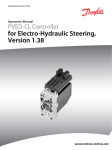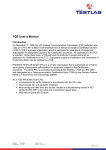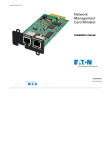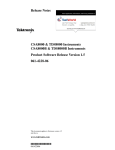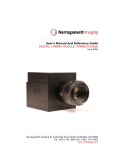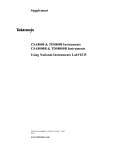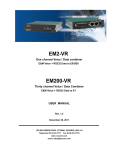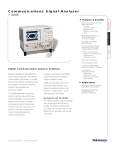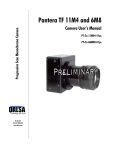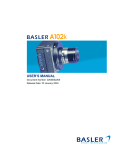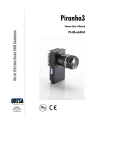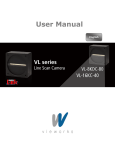Download User`s Manual
Transcript
C L S - 2 11 C A M E R A L I N K T M S I M U L ATO R User’s Manual Document # 200463, Rev 1.1, 05/27/05 Vivid Engineering 418 Boston Turnpike #104 • Shrewsbury, MA 01545 Phone 508.842.0165 • Fax 508.842.8930 Email [email protected] Web www.vividengineering.com Table of Contents 1. INTRODUCTION 2 1.1. Overview 2 1.2. Features 4 1.3. Functional Description 1.3.1. Clock Synthesizer 1.3.2. Timing Generator 1.3.3. Window Generator 1.3.4. Pattern Generator 1.3.5. Integration Timer 1.3.6. Microcontroller 1.3.7. RS-232 Serial Port 1.3.8. Camera Control Inputs 1.3.9. Channel Link Transmitters 5 6 8 11 13 18 18 18 19 19 1.4. Command Line Interface (CLI) 1.4.1. Line Valid Low (LVAL_LO) 1.4.2. Line Valid High (LVAL_HI) 1.4.3. Frame Valid Low (FVAL_LO) 1.4.4. Frame Valid High (FVAL_HI) 1.4.5. Frame Valid Setup (FVAL_SETUP) 1.4.6. Frame Valid Hold (FVAL_HOLD) 1.4.7. X Offset (X_OFFSET) 1.4.8. X Active (X_ACTIVE) 1.4.9. Y Offset (Y_OFFSET) 1.4.10. Y Active (Y_ACTIVE) 1.4.11. Pixel “A” Pattern Select (A_PATSEL) 1.4.12. Pixel “B” Pattern Select (B_PATSEL) 20 22 22 23 23 24 24 25 25 26 26 27 27 1.4.13. 1.4.14. 1.4.15. 1.4.16. 1.4.17. 1.4.18. 1.4.19. 1.4.20. 1.4.21. 1.4.22. 1.4.23. 1.4.24. 1.4.25. 1.4.26. 1.4.27. 1.4.28. 1.4.29. 1.4.30. 1.4.31. 1.4.32. 1.4.33. 1.4.34. 1.4.35. 1.4.36. 1.4.37. 1.4.38. 1.4.39. 1.4.40. 1.4.41. 1.4.42. 1.4.43. 1.4.44. 1.4.45. 1.4.46. 1.4.47. 1.4.48. 1.4.49. 1.4.50. 1.4.51. 1.4.52. 1.4.53. 1.4.54. 1.4.55. 1.4.56. 1.4.57. 1.4.58. Pixel “C” Pattern Select (C_PATSEL) Pixel “D” Pattern Select (D_PATSEL) Pixel “E” Pattern Select (E_PATSEL) Pixel “F” Pattern Select (F_PATSEL) Pixel “G” Pattern Select (G_PATSEL) Pixel “H” Pattern Select (H_PATSEL) Pixel “A” Fixed Value (A_FIXED) Pixel “B” Fixed Value (B_FIXED) Pixel “C” Fixed Value (C_FIXED) Pixel “D” Fixed Value (D_FIXED) Pixel “E” Fixed Value (E_FIXED) Pixel “F” Fixed Value (F_FIXED) Pixel “G” Fixed Value (G_FIXED) Pixel “H” Fixed Value (H_FIXED) Pixel “A” Background Value (A_BACK) Pixel “B” Background Value (B_BACK) Pixel “C” Background Value (C_BACK) Pixel “D” Background Value (D_BACK) Pixel “E” Background Value (E_BACK) Pixel “F” Background Value (F_BACK) Pixel “G” Background Value (G_BACK) Pixel “H” Background Value (H_BACK) Pixel “A” Pattern Step (A_STEP) Pixel “B” Pattern Step (B_STEP) Pixel “C” Pattern Step (C_STEP) Pixel “D” Pattern Step (D_STEP) Pixel “E” Pattern Step (E_STEP) Pixel “F” Pattern Step (F_STEP) Pixel “G” Pattern Step (G_STEP) Pixel “H” Pattern Step (H_STEP) Camera Link Mode (CL_MODE) Pattern Roll (ROLL) Clock Synthesizer Code (SYNTH_CODE) Clock Frequency (FREQUENCY) Continuous Mode (CONTINUOUS) Exsync Enable (EXSYNC_ENB) Exsync Select (EXSYNC_SEL) Integration Time (INTEG_TIME) Linescan Mode (LINESCAN) DVAL State (DVAL) CC State (CC) FPGA Version (VERSION) One Shot Trigger (ONE_SHOT) Parameter Save (SAVE) Parameter Recall (RECALL) Echo Control (ECHO) 28 28 28 29 29 30 31 31 32 32 33 33 34 34 35 35 36 36 37 37 38 38 39 39 40 41 41 42 43 43 44 45 46 47 47 48 48 48 49 50 50 51 51 51 52 52 1.4.59. Parameter Dump (DUMP) 53 1.5. Typical Application 55 1.6. Specifications 59 INTERFACE 60 2. 2.1. Front Panel Connections 2.1.1. Camera Connector Signals 2.1.2. Cable Shield Grounding 60 61 61 2.2. Rear Panel 2.2.1. DB9 Connector Signals 64 65 3. MECHANICAL 66 3.1. Dimensions 66 3.2. External Power Supply 67 4. REVISION HISTORY 68 1. Introduction 1.1. Overview The CLS-211 Camera LinkTM 1 simulator is a high-performance video test pattern generator supporting all Camera LinkTM configurations (base, medium, full). Fully programmable video timing enables the CLS-211 to mimic the timing characteristics of virtually any Camera LinkTM camera with video clock rates up-to 85 MHz. The CLS-211 is controlled using any PC, workstation, or terminal with a standard RS-232 serial port. CLS-211 control is performed via a simple, straightforward, Command Line Interface (CLI). No special software is required. Template configuration files are easily modified with user parameters and downloaded to the CLS-211. CLS-211 default (power-up) configuration is user programmable. This provides convenient recall of saved parameters and enables CLS-211 operation without a host computer. The CLS-211 also accepts configuration files developed for our original CLS-201 simulator. The CLS-211 Camera LinkTM Simulator is extremely useful for the development, test, integration, and field service of Camera LinkTM products and systems. Housed in a sturdy aluminum enclosure, the CLS-211 is well suited for industrial environments. The Camera LinkTM interface standard enables the interoperability of cameras and frame grabbers, regardless of vendor. The Automated Imaging Association (AIA) sponsors the Camera LinkTM program including the oversight Camera Link Committee, the self-certification program, and the product registry. The Camera LinkTM specification may be downloaded from the AIA website, found at www.machinevisiononline.org 1 Camera LinkTM is a trademark of the Automated Imaging Association WindowsTM is a trademark of Microsoft Corporation HyperTerminalTM is a trademark of Hilgraeve Inc. 2 Vivid Engineering Camera Link Simulator MEDIUM/FULL BASE 3 CLS-211 1.2. Features • A high-performance video test pattern generator • Supports all Camera LinkTM configurations (base, medium, full) • Fully programmable video timing; mimics virtually any camera • Advanced chipset supports video clock rates up-to 85 MHz • Area and line scan formats, image sizes to 64Kx64K • Box, line, horizontal/vertical/diagonal wedge test patterns • Programmable video pattern step sizes • “Roll” feature adds pattern motion • Triggered (exsync) mode & Integration timer • Connects to host PC/workstation/terminal serial port (RS-232) • Controlled via a simple Command Line Interface (CLI) • Example downloadable configuration file is easily modified w/ user settings • Requires no special software • Non-volatile save/recall of user settings • Can operate stand-alone • Sturdy, compact aluminum enclosure w/ mounting flange • External multi-nation power supply and RS-232 cable included • 3-year warrantee 4 1.3. Functional Description The CLS-211 Camera LinkTM Simulator is a programmable video test pattern generator supporting all Camera LinkTM configurations (base, medium, full). A block diagram of the CLS-211 is provided in Figure 1-1. Descriptions of the functional blocks are provided in the following sections. The CLS-211 combines video test pattern generation circuits implemented in Field Programmable Gate Array (FPGA) technology with an on-board microcontroller. The FPGA-based video test pattern circuitry provides the desired video timing, active window, and test pattern characteristics. The microcontroller links the pattern generation circuitry to the host computer and incorporates a simple, straightforward Command Line Interface (CLI). This enables the CLS-211 to be controlled using any computer incorporating a standard RS-232 serial port. Users may interactively assign settings via the CLI, or may download configuration files created in advance. The CLS-211 incorporates non-volatile memory for storing user configuration settings. Saved settings are automatically loaded upon power-up, enabling operation of the CLS-211 using pre-loaded parameters without a host computer. The CLS-211 Camera LinkTM Simulator incorporates a clock synthesizer which enables the user to select virtually any test pattern clock frequencies in the extended Camera LinkTM 20-85 MHz range. The camera control inputs of the Camera LinkTM interface are sent to timing generator for use as exsync inputs, enabling the frame grabber to trigger pattern generation and an integration timer adds camera exposure characteristics. The serial link in the Camera LinkTM interface is looped back to the frame grabber, enabling loopback test of the serial interface. The CLS-211 camera interface incorporates the connector, signals, pinout, and chipset in compliance with the Camera LinkTM specification. The CLS-211 incorporates the “base”, “medium” and “full” configuration signal sets, consisting of video data, camera control, and serial communications. The CLS-211 is powered by an external multi-nation wall plug-in power supply which is included. Also included is an RS-232 serial cable. 5 Integ. Timer To PC RS-232 Port Clock Synth Timing Generator Window Generator Pattern Generator Channel Channel Channel Link Link Link Xmtrs Xmtrs Xmtrs Camera Control Video Data Serial Comm Serial Port RS-232 Serial Comm Processor To Camera LinkTM Frame Grabber LVDS Receiver Configuration Memory Microcontroller CLS-211 Camera LinkTM Simulator Figure 1-1: CLS-211 Block Diagram 1.3.1. Clock Synthesizer The CLS-211 Camera LinkTM Simulator incorporates a clock synthesizer circuit to generate the reference clock for the video test patterns. The clock synthesizer is capable of generating virtually any reference clock frequency in the extended Camera LinkTM 20-85 MHz range. The reference clock is used by the timing, window, and pattern generation circuitry and is also sent to the frame grabber via the Camera LinkTM interface. As with all CLS-211 user parameters, clock frequency settings are stored to non-volatile memory in response to a parameter save command. Stored clock settings are automatically retrieved from memory upon power-up, or in response to a parameter recall command. The CLS-211 clock synthesizer chip is an ICS307M-02 made by Integrated Clock Solutions, Inc. (ICS). The CLS-211 Command Line Interface (CLI) incorporates two commands for selecting the reference clock frequency. With the frequency command, the user simply specifies an integer frequency between 20 and 85 MHz (i.e. 20,21,22…85). 6 For fractional frequencies (i.e. 27.375 MHz), the synth_code command allows direct input of the programming code into the clock synthesizer chip. An online synthesizer code generation tool is available on the Integrated Clock Solutions (ICS) website at http://www.icst.com/calculators/ics307inputForm.html Simply follow the link and enter the following parameters into the window: • In the Input Frequency box, enter "14.31818" • Enter desired frequency • Enter desired accuracy • In the Clock 2 Output box, select "OFF" • In the Output Driver box, select "CMOS” • In the Crystal Load Capacitance box, select "00” • Click on the “Calculate” button Example: Running the tool for a desired frequency of 27.375 MHz will return several codes based on best accuracy, lowest jitter, etc. The best accuracy code is 0x248939. To load this code into CLS-211, type "SYNTH_CODE 0x248939" at the command line prompt. 7 1.3.2. Timing Generator The CLS-211 Camera LinkTM Simulator timing generator establishes the basic video timing characteristics by generating the Line Valid (LVAL) and Frame Valid (FVAL) timing signals. The circuit operates at the reference clock frequency programmed into the clock synthesizer. LVAL is used to envelope lines of video data and is defined in the Camera LinkTM specification as high for valid line data. Two CLS-211 timing parameters, LVAL_LO and LVAL_HI, determine the duration of LVAL low and high states in pixel clock cycles, respectively. The frequency of the pixel clock is determined by the clock synthesizer. The CLS-211 supports “LVAL low” and “LVAL high” times from 165535 pixel clocks. LVAL timing characteristics are shown in Figure 1-2. Note: The LVAL timing signal is continuously output whenever the CLS-211 is operated in framescan mode. For linescan mode, LVAL is continuous when in operating in “continuous” mode. For linescan mode with exsync triggering, a single LVAL pulse is issued in response to each triggering event. Line Valid (LVAL) Line Valid High Parameter: LVAL_HI Range: 1-65535 clocks Line Valid Low Parameter: LVAL_LO Range: 1-65535 clocks Figure 1-2: Line Valid (LVAL) Timing Characteristics 8 FVAL is used to envelope frames of video data from framescan cameras and is defined in the Camera LinkTM specification as high for valid frame data. Two CLS211 timing parameters, FVAL_LO and FVAL_HI, determine the duration of FVAL low and high states in video lines, respectively. Video lines refer to the Line Valid (LVAL) signal which was discussed in the prior paragraph. The CLS-211 supports FVAL low and FVAL high times from 1-65535 lines. FVAL timing characteristics are shown in Figure 1-3. Frame Valid (FVAL) Frame Valid High Parameter: FVAL_HI Range: 1-65535 lines Frame Valid Low Parameter: FVAL_LO Range: 1-65535 lines Figure 1-3: Frame Valid (FVAL) Timing Characteristics The relative positioning of the FVAL and LVAL timing signals is programmable and is specified using the Frame Valid Setup (FVAL_SETUP) and Frame Valid Hold (FVAL_HOLD) parameters. ≈ When FVAL_SETUP and FVAL_HOLD are both set to 0, the default condition occurs whereby transitions on the FVAL signal occur coincident with the falling edge of the LVAL signal (the start of the horizontal blank interval). This relationship is illustrated in Figure 1-4. ≈ Line Valid (LVAL) Frame Valid (FVAL) FVAL_SETUP = 0 FVAL_HOLD = 0 Figure 1-4: Default LVAL/FVAL Timing Relationship 9 ≈ The FVAL_SETUP and FVAL_HOLD parameters allow CLS-211 timing characteristics to be fine tuned in order to mimic camera characteristics, verify frame grabber functionality, etc. Figure 1-5 illustrates how a value inserted in the FVAL_SETUP results in the rising edge of FVAL occurring in advance of the falling edge of LVAL. The figure also illustrates how FVAL_HOLD values result in the falling edge of FVAL occurring after the falling edge of LVAL. ≈ Line Valid (LVAL) Frame Valid (FVAL) Frame Valid Setup Parameter: FVAL_SETUP Range: 0-65535 clocks Frame Valid Hold Parameter: FVAL_HOLD Range: 0-65535 clocks Figure 1-5: FVAL Setup/Hold Timing Parameters 10 1.3.3. Window Generator The CLS-211 Camera LinkTM Simulator incorporates a programmable window generator that determines the size and position of the video test pattern. The window generator accepts four parameters to determine the position and size of the video test pattern relative to the FVAL and LVAL timing signals described in Section 1.3.2 The starting position of the video test pattern is determined by the X Offset (XOFF) and Y Offset (YOFF) parameters. XOFF determines the staring position within a line (“x” position), and the YOFF parameter determines the starting row (“y” position). Test pattern image size is defined using the XACT and XOFF parameters. X Active (XACT) determines the horizontal test pattern size in pixels, and Y Active (YACT) determines the vertical pattern size in lines. Figure 1-6 shows the test pattern line positioning relative to LVAL. Figure 1-7 illustrates the window generation characteristics based on XOFF, YOFF, XACT, and XACT. ≈ Line Valid (LVAL) Pixel 1 Test Pattern Pixels Pixel 2 X Offset Parameter: X_OFFSET Range: 0-65535 clocks Pixel 3 Pixel 4 Pixel 5 Pixel N-1 X Active Parameter: X_ACTIVE Range: 1-65535 clocks Figure 1-6: Horizontal (X) Offset/Active Parameters 11 Pixel N Total Pixels per Line = LVAL_HI Total Lines per Frame = FVAL_HI "Y" Offset Parameter: YOFF Range: 0-65535 lines "X" Offset Parameter: XOFF Range: 0-65535 pixels TEST PATTERN ACTIVE WINDOW "X" Active Parameter: XACT Range: 1-65535 pixels Figure 1-7: Window Generator Characteristics 12 "Y" Active Parameter: YACT Range: 1-65535 lines 1.3.4. Pattern Generator The CLS-211 Camera LinkTM Simulator incorporates a programmable pattern generator to create a variety of test patterns. The CLS-211 is capable of generating rectangular fixed-value, horizontal wedge, vertical wedge, and diagonal wedge patterns as shown in Figures 1-8 through 1-11. The rectangular fixed-value pattern may be any width or height (i.e. vertical line, horizontal line, dot, square, etc), in any position, and with selectable foreground and background pixel values. The CLS-211 enables the user to individually select the test pattern for up-to eight pixel outputs (A/B/C/D/E/F/G/H) in the multi-tap and color modes. To support this feature, eight Pattern Select (A_PATSEL, B_PATSEL, C_PATSEL, D_PATSEL, E_PATSEL, F_PATSEL, G_PATSEL, H_PATSEL) parameters are provided. The PATSEL parameters are defined in Table 1-1. Table 1-1: PATSEL Parameter Definition Pattern Select Value (A_PATSEL, B_PATSEL, C_PATSEL, D_PATSEL (E_PATSEL, F_PATSEL, G_PATSEL, H_PATSEL) Video Test Pattern 0 Fixed Value (rectangular) 1 Horizontal Wedge 2 Vertical Wedge 3 Diagonal Wedge For the fixed value pattern, eight Pixel Fixed Value (A_FIXED, B_FIXED, C_FIXED, D_FIXED, E_FIXED, F_FIXED, G_FIXED, H_FIXED) parameters are provided to individually select static pixel values for the up-to eight pixels that are being simultaneously output. 13 The CLS-211 enables the user to select background pixel values. These are the default output pixel values at all times outside the active video region defined by the window generator. The CLS-211 enables the user to individually select the background value for each of the up-to eight pixel outputs (A/B/C/D/E/F/G/H). To support this feature, eight Pixel Background Value (A_BACK, B_BACK, C_BACK, D_BACK, E_BACK, F_BACK, G_BACK, H_BACK) parameters are provided. The CLS-211 provides a selectable pixel step size when generating wedge (horizontal, vertical, diagonal). The step size determines the amount by which pixel values are incremented from pixel-to-pixel in the test patterns. The default setting of “1” causes the pixel values to increment by 1. Step sizes of 2, 4, 8, 16, 32, 64 and 128 are also supported. The pixel step size feature is particularly valuable when working with high-resolution (i.e. 12 or 16-bit) video. The CLS-211 enables the user to individually select the step size for each of the up-to eight pixel outputs (A/B/C/D/E/F/G/H). To support this feature, eight Pixel Step Size (A_STEP, B_ STEP, C_ STEP, D_ STEP, E_ STEP, F_ STEP, G_ STEP, H_ STEP) parameters are provided The CLS-210 “roll” feature used in conjunction with the wedge patterns (horizontal, vertical, diagonal) to introduce test pattern motion. When roll is enabled, the starting pixel value in the video test pattern increments every frame. This changes all pixel values within the pattern every frame and adds a “rolling” motion to the displayed pattern. This feature is particularly useful during testing and for debugging image acquisition problems. The CLS-211 supports all modes defined in the Camera LinkTM specification for the “base”, “medium”, and “full” configurations. These modes range from simple 8-bit single-tap, to 12-bits by 4-taps, to 8-bits by 8-taps. The desired mode is selected using the Camera Link Mode (CL_MODE) parameter. The CL_MODE parameter is defined in Table 1-2. For simplicity, the CLS-211 refers to A-B-C-D-E-F-G-H “pixels”, not “ports”. The CLS-211 outputs up-to eight pixels simultaneously, depending on Camera LinkTM mode. The pixel values are automatically mapped to the corresponding port assignments as defined in the Camera LinkTM specification. 14 Table 1-1: CL_MODE Parameter Definition CL_MODE Parameter Setting (decimal) Camera Link Mode 0 8-bit x 1~3 (base configuration) 1 10-bit x 1~2 (base configuration) 2 12-bit x 1~2 (base configuration) 3 14-bit x 1 (base configuration) 4 16-bit x 1 (base configuration) 5 24-bit RGB (base configuration) 8 8-bit x 4 (medium configuration) 9 10-bit x 3~4 (medium configuration) 10 12-bit x 3~4 (medium configuration) 11 30-bit RGB (medium configuration) 12 36-bit RGB (medium configuration) 15 8-bit x 8 (full configuration) 15 Figure 1-8: Fixed (Rectangular) Test Pattern Figure 1-9: Horizontal Wedge Test Pattern 16 Figure 1-10: Vertical Wedge Test Pattern Figure 1-11: Diagonal Wedge Test Pattern 17 1.3.5. Integration Timer The CLS-211 incorporates an integration timer which may be used to simulate camera exposure characteristics. The integration timer operates off a fixed clock reference and has a range of 0 to 65 seconds in 1ms steps. The integration timer is used to mimic camera integration (exposure) characteristics by delaying the generation of video frames for a period of time representing the integration interval. The integration timer may be used in conjunction with either continuous or triggered (exsync) mode. In continuous mode, the integration timer determines the video frame rate and can be set to mimic very long (up-to 65s) integration periods. In triggered (exsync) mode, the generation of a video frame in response to a triggering event is delayed by the time programmed into the counter in order to mimic an integration interval. 1.3.6. Microcontroller The CLS-211 Camera LinkTM Simulator utilizes a microcontroller device to implement a Command Line Interface (CLI). The CLI enables a PC or workstation to control and monitor CLS-211 functions. The microcontroller interprets commands received over the CLI and configures the CLS-211 circuitry accordingly. The serial communication protocol between the PC/workstation and the CLS-211 is supported by the microcontroller’s built-in Universal Asynchronous Receiver/Transmitter (UART). The microcontroller incorporates non-volatile configuration memory for the storage of user-selected parameters. Upon power-up initialization, the CLS-211 automatically recalls the parameter set stored in memory. This feature enables operation of the CLS211 without a control port connection. The CLI Parameter Save (SAVE) command is used to store the current parameter set to the configuration memory. The CLI Parameter Recall (RECALL) command configures the CLS-211 using the parameter set currently stored. 1.3.7. RS-232 Serial Port The CLS-211 Camera LinkTM Simulator incorporates an industry-standard RS-232 serial port for linking the CLS-211 to a host PC or workstation. The serial port provides RS-232 signal characteristics and incorporates a standard 9-pin D-Sub (DB9) 18 connector. The serial port protocol settings are conventional and are defined in Table 1-3. Connector information is provided in Section 2.2. Table 1-3: RS-232 Serial Port Settings Port Characteristic Setting Rate (bits per second) 9600 Data Bits 8 Parity None Stop Bits 1 Flow Control None 1.3.8. Camera Control Inputs The CLS-211 Camera LinkTM Simulator receives four Camera Control (CC1, CC2, CC3, CC4) from the frame grabber as defined in the Camera LinkTM specification. The camera control signal states can be monitored using the CLI, or used as an exsync input to trigger frame/line output. CLS-211 can be programmed to select a camera control input (CC1, CC2, CC3, or CC4) for use as an exsync trigger. Exsync trigger polarity (rising or falling edge) is also programmable. When configured, the CLS-211 will issue a single frame (or line in linescan mode) in response to each exsync trigger received. 1.3.9. Channel Link Transmitters The CLS-211 Camera LinkTM Simulator incorporates Channel Link transmitter devices for outputting video timing, data, and clock in compliance with the Camera LinkTM specification. Three Channel Link transmitter devices are used, one for the “base” connector and two for the “medium/full” connector. High-performance devices are utilized to support the “extended” Camera Link maximum pixel clock frequency of 85 MHz. The Channel Link transmitter chips are National Semiconductor DS90CR287MTD. 19 1.4. Command Line Interface (CLI) The CLS-211 Camera LinkTM Simulator incorporates a Command Line Interface (CLI) which enables CLS-211 control and monitoring using virtually any PC, workstation, or terminal. The CLS-211 requires no special software. Once the CLS-211 is connected to a host computer RS-232 port, the user accesses the CLS-211 using standard communications software. HyperTerminalTM included in the WindowsTM software works well as does almost any basic communications software package. By default, the CLS-211 echoes-back all characters received. The Echo Control (ECHO) command enables the user to enable/disable echo. Disabling echo is sometimes desired, in particular when large configuration files are being downloaded to the CLS-211. Serial port settings are listed in Section 1.3.7. HyperTerminalTM Note: The CLS-211 serial port interface does not incorporate flow control. While data buffering is performed, it is still possible to overrun the CLS-211 receive buffer, especially when downloading large configuration files. This will be visible as lost characters on the console and/or “invalid entry” responses from the CLS-211. The following methods may be used to avoid these problems: 1. Turn off message echo when downloading large configuration files. Turning of echo is performed via the Echo Control (ECHO) command. 2. In HyperTerminalTM , click on the Files menu. Then click on Properties - Settings ASCII Setup - and enter a “1” for the character delay and/or the line delay. Upon power-up, the CLS-211 performs system initialization and will respond with a message similar to the following: CLS-211 initializing, please wait . . . . . . . . . . . . . . . . . . . . . . . . ready Following initialization, the CLS-211 then sends the PC a message similar to the following: 20 CLS211 Camera Link Simulator CLI Vivid Engineering Rev 1.01 The CLS-211 recognizes the commands defined in the following sections. The DUMP, SAVE, and RECALL commands are particularly useful. In the case of invalid syntax, the CLS-211 responds with the following: invalid entry All numeric entries are made using either decimal or hexadecimal (0x…) notation. The only exception is the long Clock Synthesizer Code (SYNTH_CODE) command which is always entered as hexadecimal. CLS-211 parameters may be entered manually on the keyboard, or may be downloaded to the CLS-211 as a configuration file. Configuration files are plain text format (i.e. “.txt” files) and may be created with an editor, word processor, etc. Spaces and returns may be inserted as desired for readability. Comments are indicated using a backslash “/” and may be located at the start of a line or following a command. The following is an example of comments located in a configuration file. Note that all numeric information must be in either decimal or hexadecimal (0x…) format. An example configuration file is found in Section 1-5. // // Camera Link Configuration File - syntax example LVAL_LO LVAL_HI Fval_lo 0x0020 500 0x20 // hexadecimal notation // decimal notation // hexadecimal notation Methods for downloading text (.txt) files to the CLS-211 vary depending on the communications software used. For HyperTerminalTM (included with WindowsTM), click on the “Transfer” toolbar and select “Send Text File”. HyperTerminalTM will then prompt for the location of the file. The CLS-211 command set is defined in the following sections. 21 1.4.1. Line Valid Low (LVAL_LO) The Line Valid Low (LVAL_LO) command is used to establish the duration, in clock cycles for the “low” (logic 0) portion of the Camera LinkTM Line Valid timing signal. See Section 1.3.2 for further information. Parameter: Range: Type: LVAL_LO 1-65535 clocks (hex 0x1 - 0xFFFF) Read/Write Write Example: LVAL_LO 0xA000 Read Example: LVAL_LO ? 1.4.2. Line Valid High (LVAL_HI) The Line Valid High (LVAL_HI) command is used to establish the duration, in clock cycles for the “high” (logic 1) portion of the Camera LinkTM Line Valid timing signal. See Section 1.3.2 for further information. Parameter: Range: Type: LVAL_HI 1-65535 clocks (hex 0x1 - 0xFFFF) Read/Write Write Example: LVAL_HI 0xB000 Read Example: LVAL_HI ? 22 1.4.3. Frame Valid Low (FVAL_LO) The Frame Valid Low (FVAL_LO) command is used to establish the duration, in lines for the “low” (logic 0) portion of the Camera LinkTM Frame Valid timing signal. See Section 1.3.2 for further information. Parameter: Range: Type: FVAL_LO 1-65535 lines (hex 0x1 - 0xFFFF) Read/Write Write Example: FVAL_LO 0xC000 Read Example: FVAL_LO ? 1.4.4. Frame Valid High (FVAL_HI) The Frame Valid High (FVAL_HI) command is used to establish the duration, in lines for the “high” (logic 1) portion of the Camera LinkTM Frame Valid timing signal. See Section 1.3.2 for further information. Parameter: Range: Type: FVAL_HI 1-65535 lines (hex 0x1 - 0xFFFF) Read/Write Write Example: FVAL_HI 0xD000 Read Example: FVAL_HI ? 23 1.4.5. Frame Valid Setup (FVAL_SETUP) The Frame Valid Setup (FVAL_SETUP) command determines the number of clock cycles that the rising edge of the Camera LinkTM FVAL signal occurs in advance of the falling edge of the LVAL signal. When FVAL_SETUP is set to 0, the rising edge of FVAL is coincident with the falling edge of LVAL. See Section 1.3.2 for further information. Parameter: Range: Type: FVAL_SETUP 0-65535 clocks (hex 0x0 - 0xFFFF) Read/Write Write Example: FVAL_SETUP 0xE000 Read Example: FVAL_SETUP ? 1.4.6. Frame Valid Hold (FVAL_HOLD) The Frame Valid Hold (FVAL_HOLD) command determines the number of clock cycles that the falling edge of the Camera LinkTM FVAL signal occurs following the falling edge of the LVAL signal. When FVAL_HOLD is set to 0, the falling edge of FVAL is coincident with the falling edge of LVAL. See Section 1.3.2 for further information. Parameter: Range: Type: FVAL_HOLD 0-65535 clocks (hex 0x0 - 0xFFFF) Read/Write Write Example: FVAL_HOLD 0x1000 Read Example: FVAL_HOLD ? 24 1.4.7. X Offset (X_OFFSET) The X Offset (X_OFFSET) command determines the number of clock cycles from the rising edge of the Camera LinkTM LVAL signal to the start of test pattern data (i.e. horizontal start position). When X_OFFSET is set to 0, line test pattern data begins immediately following the rising edge of LVAL. See Section 1.3.3 for further information. Parameter: Range: Type: X_OFFSET 0-65535 clocks (hex 0x0 - 0xFFFF) Read/Write Write Example: X_OFFSET 0x2000 Read Example: X_OFFSET ? 1.4.8. X Active (X_ACTIVE) The X Active (X_ACTIVE) command determines the horizontal size (x dimension) of the test pattern in clock cycles. See Section 1.3.3 for further information. Parameter: Range: Type: X_ACTIVE 1-65535 clocks (hex 0x1 - 0xFFFF) Read/Write Write Example: X_ACTIVE 0x3000 Read Example: X_ACTIVE ? 25 1.4.9. Y Offset (Y_OFFSET) The Y Offset (Y_OFFSET) command determines the number of lines from the rising edge of the Camera LinkTM FVAL signal to the start of test pattern data (i.e. vertical start position). When Y_OFFSET is set to 0, the test pattern data begins with the next line. See Section 1.3.3 for further information. Parameter: Range: Type: Y_OFFSET 0-65535 clocks (hex 0x0 - 0xFFFF) Read/Write Write Example: Y_OFFSET 0x4000 Read Example: Y_OFFSET ? 1.4.10. Y Active (Y_ACTIVE) The Y Active (Y_ACTIVE) command determines the vertical size (y dimension) of the test pattern in lines. See Section 1.3.3 for further information. Parameter: Range: Type: Y_ACTIVE 1-65535 lines (hex 0x1 - 0xFFFF) Read/Write Write Example: Y_ACTIVE 0x5000 Read Example: Y_ACTIVE ? 26 1.4.11. Pixel “A” Pattern Select (A_PATSEL) The Pixel “A” Pattern Select (A_PATSEL) command assigns the test pattern for video data pixel “A”. The CLS-211 outputs up-to eight pixels simultaneously (A,B,C,D,E,F,G,H), depending on output mode (see CL_MODE command). See Section 1.3.4 for further information. Parameter: Settings: Type: A_PATSEL 0x0 = Fixed Value 0x1 = Horizontal Wedge 0x2 = Vertical Wedge 0x3 = Diagonal Wedge Read/Write Write Example: A_PATSEL 0x0 Read Example: A_PATSEL ? 1.4.12. Pixel “B” Pattern Select (B_PATSEL) The Pixel “B” Pattern Select (B_PATSEL) command assigns the test pattern for video data pixel “B”. The CLS-211 outputs up-to eight pixels simultaneously (A,B,C,D,E,F,G,H), depending on output mode (see CL_MODE command). See Section 1.3.4 for further information. Parameter: Settings: Type: B_PATSEL 0 (0x0) = Fixed Value 1 (0x1) = Horizontal Wedge 2 (0x2) = Vertical Wedge 3 (0x3) = Diagonal Wedge Read/Write Write Example: B_PATSEL 0x2 Read Example: B_PATSEL ? 27 1.4.13. Pixel “C” Pattern Select (C_PATSEL) The Pixel “C” Pattern Select (C_PATSEL) command assigns the test pattern for video data pixel “C”. The CLS-211 outputs up-to eight pixels simultaneously (A,B,C,D,E,F,G,H), depending on output mode (see CL_MODE command). See Section 1.3.4 for further information. Parameter: Settings: Type: C_PATSEL 0 (0x0) = Fixed Value 1 (0x1) = Horizontal Wedge 2 (0x2) = Vertical Wedge 3 (0x3) = Diagonal Wedge Read/Write Write Example: C_PATSEL 0x2 Read Example: C_PATSEL ? 1.4.14. Pixel “D” Pattern Select (D_PATSEL) The Pixel “D” Pattern Select (D_PATSEL) command assigns the test pattern for video data pixel “D”. The CLS-211 outputs up-to eight pixels simultaneously (A,B,C,D,E,F,G,H), depending on output mode (see CL_MODE command). See Section 1.3.4 for further information. Parameter: Settings: Type: D_PATSEL 0 (0x0) = Fixed Value 1 (0x1) = Horizontal Wedge 2 (0x2) = Vertical Wedge 3 (0x3) = Diagonal Wedge Read/Write Write Example: D_PATSEL 0x3 Read Example: D_PATSEL ? 1.4.15. Pixel “E” Pattern Select (E_PATSEL) The Pixel “E” Pattern Select (E_PATSEL) command assigns the test pattern for video data pixel “E”. The CLS-211 outputs up-to eight pixels simultaneously (A,B,C,D,E,F,G,H), depending on output mode (see CL_MODE command). See Section 1.3.4 for further information. 28 Parameter: Settings: Type: E_PATSEL 0 (0x0) = Fixed Value 1 (0x1) = Horizontal Wedge 2 (0x2) = Vertical Wedge 3 (0x3) = Diagonal Wedge Read/Write Write Example: E_PATSEL 0x3 Read Example: E_PATSEL ? 1.4.16. Pixel “F” Pattern Select (F_PATSEL) The Pixel “F” Pattern Select (F_PATSEL) command assigns the test pattern for video data pixel “F”. The CLS-211 outputs up-to eight pixels simultaneously (A,B,C,D,E,F,G,H), depending on output mode (see CL_MODE command). See Section 1.3.4 for further information. Parameter: Settings: Type: F_PATSEL 0 (0x0) = Fixed Value 1 (0x1) = Horizontal Wedge 2 (0x2) = Vertical Wedge 3 (0x3) = Diagonal Wedge Read/Write Write Example: F_PATSEL 0x3 Read Example: F_PATSEL ? 1.4.17. Pixel “G” Pattern Select (G_PATSEL) The Pixel “G” Pattern Select (G_PATSEL) command assigns the test pattern for video data pixel “G”. The CLS-211 outputs up-to eight pixels simultaneously (A,B,C,D,E,F,G,H), depending on output mode (see CL_MODE command). See Section 1.3.4 for further information. Parameter: Settings: Type: G_PATSEL 0 (0x0) = Fixed Value 1 (0x1) = Horizontal Wedge 2 (0x2) = Vertical Wedge 3 (0x3) = Diagonal Wedge Read/Write 29 Write Example: G_PATSEL 0x3 Read Example: G_PATSEL ? 1.4.18. Pixel “H” Pattern Select (H_PATSEL) The Pixel “H” Pattern Select (H_PATSEL) command assigns the test pattern for video data pixel “H”. The CLS-211 outputs up-to eight pixels simultaneously (A,B,C,D,E,F,G,H), depending on output mode (see CL_MODE command). See Section 1.3.4 for further information. Parameter: Settings: Type: H_PATSEL 0 (0x0) = Fixed Value 1 (0x1) = Horizontal Wedge 2 (0x2) = Vertical Wedge 3 (0x3) = Diagonal Wedge Read/Write Write Example: H_PATSEL 0x3 Read Example: H_PATSEL ? 30 1.4.19. Pixel “A” Fixed Value (A_FIXED) The Pixel “A” Fixed Value (A_FIXED) command determines the pixel “A” value when the fixed pattern is selected (A_PATSEL = 0). The CLS-211 outputs up-to eight pixels simultaneously (A,B,C,D,E,F,G,H), depending on output mode (see CL_MODE command). See Section 1.3.4 for further information. Parameter: Range: Type: A_FIXED Depends on pixel size. 0-65535 (hex 0x0 - 0xFFFF) max. Read/Write Write Example: A_FIXED 0xA5A5 Read Example: A_FIXED ? 1.4.20. Pixel “B” Fixed Value (B_FIXED) The Pixel “B” Fixed Value (B_FIXED) command determines the pixel “B” value when the fixed pattern is selected (B_PATSEL = 0). The CLS-211 outputs up-to eight pixels simultaneously (A,B,C,D,E,F,G,H), depending on output mode (see CL_MODE command). See Section 1.3.4 for further information. Parameter: Range: Type: B_FIXED Depends on pixel size. 0-4095 (hex 0x0 - 0xFFF) max. Read/Write Write Example: B_FIXED 0x5A5 Read Example: B_FIXED ? 31 1.4.21. Pixel “C” Fixed Value (C_FIXED) The Pixel “C” Fixed Value (C_FIXED) command determines the pixel “C” value when the fixed pattern is selected (C_PATSEL = 0). The CLS-211 outputs up-to eight pixels simultaneously (A,B,C,D,E,F,G,H), depending on output mode (see CL_MODE command). See Section 1.3.4 for further information. Parameter: Range: Type: C_FIXED Depends on pixel size. 0-4095 (hex 0x0 - 0xFFF) max. Read/Write Write Example: C_FIXED 0x3C3 Read Example: C_FIXED ? 1.4.22. Pixel “D” Fixed Value (D_FIXED) The Pixel “D” Fixed Value (D_FIXED) command determines the pixel “D” value when the fixed pattern is selected (D_PATSEL = 0). The CLS-211 outputs up-to eight pixels simultaneously (A,B,C,D,E,F,G,H), depending on output mode (see CL_MODE command). See Section 1.3.4 for further information. Parameter: Range: Type: D_FIXED Depends on pixel size. 0-4095 (hex 0x0 - 0xFFF) max. Read/Write Write Example: D_FIXED 0xC3C Read Example: D_FIXED ? 32 1.4.23. Pixel “E” Fixed Value (E_FIXED) The Pixel “E” Fixed Value (E_FIXED) command determines the pixel “E” value when the fixed pattern is selected (E_PATSEL = 0). The CLS-211 outputs up-to eight pixels simultaneously (A,B,C,D,E,F,G,H), depending on output mode (see CL_MODE command). See Section 1.3.4 for further information. Parameter: Range: Type: E_FIXED 0-255 (hex 0x0 - 0xFF) Read/Write Write Example: E_FIXED 0x3C Read Example: E_FIXED ? 1.4.24. Pixel “F” Fixed Value (F_FIXED) The Pixel “F” Fixed Value (F_FIXED) command determines the pixel “F” value when the fixed pattern is selected (F_PATSEL = 0). The CLS-211 outputs up-to eight pixels simultaneously (A,B,C,D,E,F,G,H), depending on output mode (see CL_MODE command). See Section 1.3.4 for further information. Parameter: Range: Type: F_FIXED 0-255 (hex 0x0 - 0xFF) Read/Write Write Example: F_FIXED 0x3C Read Example: F_FIXED ? 33 1.4.25. Pixel “G” Fixed Value (G_FIXED) The Pixel “G” Fixed Value (G_FIXED) command determines the pixel “G” value when the fixed pattern is selected (G_PATSEL = 0). The CLS-211 outputs up-to eight pixels simultaneously (A,B,C,D,E,F,G,H), depending on output mode (see CL_MODE command). See Section 1.3.4 for further information. Parameter: Range: Type: G_FIXED 0-255 (hex 0x0 - 0xFF) Read/Write Write Example: G_FIXED 0x3C Read Example: G_FIXED ? 1.4.26. Pixel “H” Fixed Value (H_FIXED) The Pixel “H” Fixed Value (H_FIXED) command determines the pixel “H” value when the fixed pattern is selected (H_PATSEL = 0). The CLS-211 outputs up-to eight pixels simultaneously (A,B,C,D,E,F,G,H), depending on output mode (see CL_MODE command). See Section 1.3.4 for further information. Parameter: Range: Type: H_FIXED 0-255 (hex 0x0 - 0xFF) Read/Write Write Example: H_FIXED 0x3C Read Example: H_FIXED ? 34 1.4.27. Pixel “A” Background Value (A_BACK) The Pixel “A” Background Value (A_BACK) command determines the default value for video data pixel “A”. The default value is output whenever the CLS-211 is not outputting video test pattern data. The CLS-211 outputs up-to eight pixels simultaneously (A,B,C,D,E,F,G,H), depending on output mode (see CL_MODE command). See Section 1.3.4 for further information. Parameter: Range: Type: A_BACK Depends on pixel size. 0-65535 (hex 0x0 - 0xFFFF) max. Read/Write Write Example: A_BACK 0xA5A5 Read Example: A_BACK ? 1.4.28. Pixel “B” Background Value (B_BACK) The Pixel “B” Background Value (B_BACK) command determines the default value for video data pixel “B”. The default value is output whenever the CLS-211 is not outputting video test pattern data. The CLS-211 outputs up-to eight pixels simultaneously (A,B,C,D,E,F,G,H), depending on output mode (see CL_MODE command). See Section 1.3.4 for further information. Range: Type: Depends on pixel size. 0-4095 (hex 0x0 - 0xFFF) max. Read/Write Write Example: B_BACK 0x5A5 Read Example: B_BACK ? 35 1.4.29. Pixel “C” Background Value (C_BACK) The Pixel “C” Background Value (C_BACK) command determines the default value for video data pixel “C”. The default value is output whenever the CLS-211 is not outputting video test pattern data. The CLS-211 outputs up-to eight pixels simultaneously (A,B,C,D,E,F,G,H), depending on output mode (see CL_MODE command). See Section 1.3.4 for further information. Parameter: Range: Type: C_BACK Depends on pixel size. 0-4095 (hex 0x0 - 0xFFF) max. Read/Write Write Example: C_BACK 0xC3C Read Example: C_BACK ? 1.4.30. Pixel “D” Background Value (D_BACK) The Pixel “D” Background Value (D_BACK) command determines the default value for video data pixel “D”. The default value is output whenever the CLS-211 is not outputting video test pattern data. The CLS-211 outputs up-to eight pixels simultaneously (A,B,C,D,E,F,G,H), depending on output mode (see CL_MODE command). See Section 1.3.4 for further information. Parameter: Range: Type: D_BACK Depends on pixel size. 0-4095 (hex 0x0 - 0xFFF) max. Read/Write Write Example: D_BACK 0x3C3 Read Example: D_BACK ? 36 1.4.31. Pixel “E” Background Value (E_BACK) The Pixel “E” Background Value (E_BACK) command determines the default value for video data pixel “E”. The default value is output whenever the CLS-211 is not outputting video test pattern data. The CLS-211 outputs up-to eight pixels simultaneously (A,B,C,D,E,F,G,H), depending on output mode (see CL_MODE command). See Section 1.3.4 for further information. Parameter: Range: Type: E_BACK 0-255 (hex 0x0 - 0xFF) Read/Write Write Example: E_BACK 0xC3 Read Example: E_BACK ? 1.4.32. Pixel “F” Background Value (F_BACK) The Pixel “F” Background Value (F_BACK) command determines the default value for video data pixel “F”. The default value is output whenever the CLS-211 is not outputting video test pattern data. The CLS-211 outputs up-to eight pixels simultaneously (A,B,C,D,E,F,G,H), depending on output mode (see CL_MODE command). See Section 1.3.4 for further information. Parameter: Range: Type: F_BACK 0-255 (hex 0x0 - 0xFF) Read/Write Write Example: F_BACK 0xC3 Read Example: F_BACK ? 37 1.4.33. Pixel “G” Background Value (G_BACK) The Pixel “G” Background Value (G_BACK) command determines the default value for video data pixel “G”. The default value is output whenever the CLS-211 is not outputting video test pattern data. The CLS-211 outputs up-to eight pixels simultaneously (A,B,C,D,E,F,G,H), depending on output mode (see CL_MODE command). See Section 1.3.4 for further information. Parameter: Range: Type: G_BACK 0-255 (hex 0x0 - 0xFF) Read/Write Write Example: G_BACK 0xC3 Read Example: G_BACK ? 1.4.34. Pixel “H” Background Value (H_BACK) The Pixel “H” Background Value (H_BACK) command determines the default value for video data pixel “H”. The default value is output whenever the CLS-211 is not outputting video test pattern data. The CLS-211 outputs up-to eight pixels simultaneously (A,B,C,D,E,F,G,H), depending on output mode (see CL_MODE command). See Section 1.3.4 for further information. Parameter: Range: Type: H_BACK 0-255 (hex 0x0 - 0xFF) Read/Write Write Example: H_BACK 0xC3 Read Example: H_BACK ? 38 1.4.35. Pixel “A” Pattern Step (A_STEP) The Pixel “A” Pattern Step (A_STEP) command determines the amount by which the “A” pixel value increments in the wedge (horizontal, vertical, diagonal) video test patterns. The CLS-211 outputs up-to eight pixels simultaneously (A,B,C,D,E,F,G,H), depending on output mode (see CL_MODE command). See Section 1.3.4 for further information. Parameter: Settings: Type: A_STEP 1 (0x1) = Increment by 1 (0,1,2…) 2 (0x2) = Increment by 2 (0,2,4…) 4 (0x2) = Increment by 4 (0,4,8…) 8 (0x8) = Increment by 8 (0,8,16…) 16 (0x10) = Increment by 16 (0,16,32…) 32 (0x20) = Increment by 32 (0,32,64…) 64 (0x40) = Increment by 64 (0,64,128…) 128 (0x80) = Increment by 128 (0,128,256…) Read/Write Write Example: A_STEP 0x2 Read Example: A_STEP ? 1.4.36. Pixel “B” Pattern Step (B_STEP) The Pixel “B” Pattern Step (B_STEP) command determines the amount by which the “B” pixel value increments in the wedge (horizontal, vertical, diagonal) video test patterns. The CLS-211 outputs up-to eight pixels simultaneously (A,B,C,D,E,F,G,H), depending on output mode (see CL_MODE command). See Section 1.3.4 for further information. Parameter: Settings: Type: B_STEP 1 (0x1) = Increment by 1 (0,1,2…) 2 (0x2) = Increment by 2 (0,2,4…) 4 (0x2) = Increment by 4 (0,4,8…) 8 (0x8) = Increment by 8 (0,8,16…) 16 (0x10) = Increment by 16 (0,16,32…) 32 (0x20) = Increment by 32 (0,32,64…) 64 (0x40) = Increment by 64 (0,64,128…) 128 (0x80) = Increment by 128 (0,128,256…) Read/Write 39 Write Example: B_STEP 0x2 Read Example: B_STEP ? 1.4.37. Pixel “C” Pattern Step (C_STEP) The Pixel “C” Pattern Step (C_STEP) command determines the amount by which the “C” pixel value increments in the wedge (horizontal, vertical, diagonal) video test patterns. The CLS-211 outputs up-to eight pixels simultaneously (A,B,C,D,E,F,G,H), depending on output mode (see CL_MODE command). See Section 1.3.4 for further information. Parameter: Settings: Type: C_STEP 1 (0x1) = Increment by 1 (0,1,2…) 2 (0x2) = Increment by 2 (0,2,4…) 4 (0x2) = Increment by 4 (0,4,8…) 8 (0x8) = Increment by 8 (0,8,16…) 16 (0x10) = Increment by 16 (0,16,32…) 32 (0x20) = Increment by 32 (0,32,64…) 64 (0x40) = Increment by 64 (0,64,128…) 128 (0x80) = Increment by 128 (0,128,256…) Read/Write Write Example: C_STEP 0x2 Read Example: C_STEP ? 40 1.4.38. Pixel “D” Pattern Step (D_STEP) The Pixel “D” Pattern Step (D_STEP) command determines the amount by which the “D” pixel value increments in the wedge (horizontal, vertical, diagonal) video test patterns. The CLS-211 outputs up-to eight pixels simultaneously (A,B,C,D,E,F,G,H), depending on output mode (see CL_MODE command). See Section 1.3.4 for further information. Parameter: Settings: Type: D_STEP 1 (0x1) = Increment by 1 (0,1,2…) 2 (0x2) = Increment by 2 (0,2,4…) 4 (0x2) = Increment by 4 (0,4,8…) 8 (0x8) = Increment by 8 (0,8,16…) 16 (0x10) = Increment by 16 (0,16,32…) 32 (0x20) = Increment by 32 (0,32,64…) 64 (0x40) = Increment by 64 (0,64,128…) 128 (0x80) = Increment by 128 (0,128,256…) Read/Write Write Example: D_STEP 0x2 Read Example: D_STEP ? 1.4.39. Pixel “E” Pattern Step (E_STEP) The Pixel “E” Pattern Step (E_STEP) command determines the amount by which the “E” pixel value increments in the wedge (horizontal, vertical, diagonal) video test patterns. The CLS-211 outputs up-to eight pixels simultaneously (A,B,C,D,E,F,G,H), depending on output mode (see CL_MODE command). See Section 1.3.4 for further information. Parameter: Settings: Type: E_STEP 1 (0x1) = Increment by 1 (0,1,2…) 2 (0x2) = Increment by 2 (0,2,4…) 4 (0x2) = Increment by 4 (0,4,8…) 8 (0x8) = Increment by 8 (0,8,16…) 16 (0x10) = Increment by 16 (0,16,32…) 32 (0x20) = Increment by 32 (0,32,64…) 64 (0x40) = Increment by 64 (0,64,128…) 128 (0x80) = Increment by 128 (0,128,256…) Read/Write 41 Write Example: E_STEP 0x2 Read Example: E_STEP ? 1.4.40. Pixel “F” Pattern Step (F_STEP) The Pixel “F” Pattern Step (F_STEP) command determines the amount by which the “F” pixel value increments in the wedge (horizontal, vertical, diagonal) video test patterns. The CLS-211 outputs up-to eight pixels simultaneously (A,B,C,D,E,F,G,H), depending on output mode (see CL_MODE command). See Section 1.3.4 for further information. Parameter: Settings: Type: F_STEP 1 (0x1) = Increment by 1 (0,1,2…) 2 (0x2) = Increment by 2 (0,2,4…) 4 (0x2) = Increment by 4 (0,4,8…) 8 (0x8) = Increment by 8 (0,8,16…) 16 (0x10) = Increment by 16 (0,16,32…) 32 (0x20) = Increment by 32 (0,32,64…) 64 (0x40) = Increment by 64 (0,64,128…) 128 (0x80) = Increment by 128 (0,128,256…) Read/Write Write Example: F_STEP 0x2 Read Example: F_STEP ? 42 1.4.41. Pixel “G” Pattern Step (G_STEP) The Pixel “G” Pattern Step (G_STEP) command determines the amount by which the “G” pixel value increments in the wedge (horizontal, vertical, diagonal) video test patterns. The CLS-211 outputs up-to eight pixels simultaneously (A,B,C,D,E,F,G,H), depending on output mode (see CL_MODE command). See Section 1.3.4 for further information. Parameter: Settings: Type: G_STEP 1 (0x1) = Increment by 1 (0,1,2…) 2 (0x2) = Increment by 2 (0,2,4…) 4 (0x2) = Increment by 4 (0,4,8…) 8 (0x8) = Increment by 8 (0,8,16…) 16 (0x10) = Increment by 16 (0,16,32…) 32 (0x20) = Increment by 32 (0,32,64…) 64 (0x40) = Increment by 64 (0,64,128…) 128 (0x80) = Increment by 128 (0,128,256…) Read/Write Write Example: G_STEP 0x2 Read Example: G_STEP ? 1.4.42. Pixel “H” Pattern Step (H_STEP) The Pixel “H” Pattern Step (H_STEP) command determines the amount by which the “H” pixel value increments in the wedge (horizontal, vertical, diagonal) video test patterns. The CLS-211 outputs up-to eight pixels simultaneously (A,B,C,D,E,F,G,H), depending on output mode (see CL_MODE command). See Section 1.3.4 for further information. Parameter: Settings: Type: H_STEP 1 (0x1) = Increment by 1 (0,1,2…) 2 (0x2) = Increment by 2 (0,2,4…) 4 (0x2) = Increment by 4 (0,4,8…) 8 (0x8) = Increment by 8 (0,8,16…) 16 (0x10) = Increment by 16 (0,16,32…) 32 (0x20) = Increment by 32 (0,32,64…) 64 (0x40) = Increment by 64 (0,64,128…) 128 (0x80) = Increment by 128 (0,128,256…) Read/Write 43 Write Example: H_STEP 0x2 Read Example: H_STEP ? 1.4.43. Camera Link Mode (CL_MODE) The Camera Link Mode (CL_MODE) command determines the test pattern pixel format. The CLS-211 generates video test patterns for all Camera Link modes supported by the Camera LinkTM “base”, “medium”, and “full” configurations. See Section 1.3.4 for further information. Parameter: Settings: Type: CL_MODE 0 (0x0) = 8-bit x 1~3 (base config) 1 (0x1) = 10-bit x 1~2 (base config) 2 (0x2) = 12-bit x 1~2 (base config) 3 (0x3) = 14-bit x 1 (base config) 4 (0x4) = 16-bit x 1 (base config) 5 (0x5) = 24-bit RGB (base config) 8 (0x8) = 8-bit x 4 (medium config) 9 (0x9) = 10-bit x 3~4 (medium config) 10 (0xA) = 12-bit x 3~4 (medium config) 11 (0xB) = 30-bit RGB (medium config) 12 (0xC) = 36-bit RGB (medium config) 15 (0xF) = 8-bit x 8 (full config) Read/Write Write Example: CL_MODE 0x2 Read Example: CL_MODE ? 44 1.4.44. Pattern Roll (ROLL) The Pattern Roll (ROLL) command adds motion to video test patterns. Roll is used in conjunction with the horizontal, diagonal, or vertical wedge patterns. When ROLL is enabled, the starting pixel value is incremented every frame. This changes all pixel values each frame and adds a “rolling” affect to the video test pattern. When disabled, the wedge test patterns are static (no change from frame to frame). See Section 1.3.4 for further information. Parameter: Settings: Type: ROLL 0 (0x0) = Roll disable 1 (0x1) = Roll enabled Read/Write Write Example: ROLL 0x1 Read Example: ROLL ? 45 1.4.45. Clock Synthesizer Code (SYNTH_CODE) The Clock Synthesizer Code (SYNTH_CODE) command enables the user to directly enter a 24-bit code into the clock synthesizer device that generates the CLS-211 reference clock. This allows the user to program the reference clock to virtually any frequency in the 20-85 MHz extended Camera LinkTM range. Two commands are provided in the CLS-211 to establish pixel clock frequency; SYNTH_CODE and FREQUENCY. SYNTH_CODE provides maximum flexibility by allowing direct entry of the 24-bit synthesizer code. FREQUENCY provides convenience by allowing the user to select any integer frequency value between 20 and 85. The most –recent SYNTH_CODE or FREQUENCY command determines the frequency. Reads of the clock command not used returns “####”. Reads of the clock command used return a value. See Section 1.3.1 for further information. NOTE: MUST BE ENTERRED IN HEXADECIMAL (0x…) NOTATION. Parameter: Settings: Type: SYNTH_CODE 24-bit Synthesizer Device Code (Hex) Read/Write Write Example: SYNTH_CODE 0x33543D Read Example: SYNTH_CODE ? 46 1.4.46. Clock Frequency (FREQUENCY) The Clock Frequency (FREQUENCY) command enables the user to select integer values for the Camera LinkTM reference clock in the 20-85 MHz range. Two commands are provided in the CLS-211 to establish pixel clock frequency; SYNTH_CODE and FREQUENCY. SYNTH_CODE provides maximum flexibility by allowing direct entry of the 24-bit synthesizer code. FREQUENCY provides convenience by allowing the user to select any integer frequency value between 20 and 85. The most –recent SYNTH_CODE or FREQUENCY command determines the frequency. Reads of the clock command not used returns “####”. Reads of the clock command used return a value. See Section 1.3.1 for further information. Parameter: Range: Type: FREQUENCY 20-85 MHz (hex 0x14 - 0x55) Read/Write Write Example: FREQUENCY 0x14 Read Example: FREQUENCY ? 1.4.47. Continuous Mode (CONTINUOUS) The Continuous Mode (CONTINUOUS) command enables continuous output of video test patterns. When continuous mode is enabled, the CLS-211 outputs continuous video data. When disabled, video pattern data is suspended, awaiting an exsync pulse, one-shot, or return to continuous mode. See Section 1.3.2 for further information. Parameter: Settings: Type: CONTINUOUS 0 (0x0) = Continuous Mode Disabled 1 (0x1) = Continuous Mode Enabled Read/Write Write Example: CONTINUOUS 0x1 Read Example: CONTINUOUS ? 47 1.4.48. Exsync Enable (EXSYNC_ENB) The Exsync Enable (EXSYNC_ENB) command enables triggered output of pattern frames (or lines in LINESCAN mode) using the camera control inputs (CC1, CC2, CC3, CC4). The exsync camera control input source and active edge are selected using the EXSYNC_SEL command. See Section 1.3.8 for further information. Parameter: Settings: Type: EXSYNC_ENB 0 (0x0) = Exsync Triggering Disabled 1 (0x1) = Exsync Triggering Enabled Read/Write Write Example: EXSYNC_ENB 0x1 Read Example: EXSYNC_ENB ? 1.4.49. Exsync Select (EXSYNC_SEL) The Exsync Select (EXSYNC_SEL) command select which camera control input and active edge is used when generating exsync-triggered video patterns. The CLS-211 supports exsync triggered frame generation using any of Camera LinkTM camera control inputs. The triggering edge is selectable as “rising” (low-to-high transition) or “falling” (high-to-low transition). See Section 1.3.8 for further information. Parameter: Settings: Type: EXSYNC_SEL 0 (0x0) = CC1 rising edge 1 (0x1) = CC1 falling edge 2 (0x2) = CC2 rising edge 3 (0x3) = CC2 falling edge 4 (0x4) = CC3 rising edge 5 (0x5) = CC3 falling edge 6 (0x6) = CC4 rising edge 7 (0x7) = CC4 falling edge Read/Write Write Example: EXSYNC_SEL 0x7 Read Example: EXSYNC_SEL ? 1.4.50. Integration Time (INTEG_TIME) The Integration Time (INTEG_TIME) command determines the amount of time (in milliseconds) to delay the generation of video frames to simulate camera integration 48 (exposure) characteristics. The INTEG_TIME command may be used in both triggered (exsync) and continuous modes. See Section 1.3.5 for further information. NOTE: ALWAYS SET REGISTER TO 0 WHEN NOT USING THIS FEATURE Parameter: Range: Type: INTEG_TIME 0-65535 mS (hex 0x0 - 0xFFF). Read/Write Write Example: INTEG_TIME 0x4000 Read Example: INTEG_TIME ? 1.4.51. Linescan Mode (LINESCAN) The Linescan Mode (LINESCAN) command places the CLS-211 in linescan mode. When linescan mode is disabled, the CLS-211 defaults to framescan mode. See Section 1.3.2 for further information. Parameter: Settings: Type: LINESCAN 0 (0x0) = Framescan Mode 1 (0x1) = Linescan Mode Read/Write Write Example: LINESCAN 0x0 Read Example: LINESCAN ? 49 1.4.52. DVAL State (DVAL) The DVAL State (DVAL) command determines the static state of the Camera LinkTM Data Valid output signal. Parameter: Settings: Type: DVAL 0 (0x0) = DVAL output set to 0 1 (0x1) = DVAL output set to 1 Read/Write Write Example: DVAL 0x0 Read Example: DVAL ? 1.4.53. CC State (CC) The CC State (CC) command is used to read the current state of the Camera LinkTM camera control inputs (CC1,CC2,CC3,CC4). This register is read only. See Section 1.3.8 for further information. Parameter: Bit positions: Type: CC bit 0 = CC1 (lsb) bit 1 = CC2 bit 2 = CC3 bit 3 = CC4 bit 4-7 = 0 Read Read Example: CC ? 50 1.4.54. FPGA Version (VERSION) The FPGA Version (VERSION) command is used to read the hardware version code for the CLS-211 Field Programmable Gate Array (FPGA) device. The standard version code is 48 (0x30). Parameter: Settings: Type: VERSION 8-bit FPGA version code (48 (0x30) standard) Read Read Example: VERSION ? 1.4.55. One Shot Trigger (ONE_SHOT) The One Shot Trigger (ONE_SHOT) command enables the triggering of a single frame (or line for linescan mode) via the CLI. Note that continuous mode must be disabled to use this feature (see CONTINUOUS command). There is no read or write data associated with this command. See Section 1.3.2 for further information. Parameter: Settings: Type: ONE_SHOT None, command only Command Example: ONE_SHOT 1.4.56. Parameter Save (SAVE) The Parameter Save (SAVE) command stores the current CLS-211 parameter set to non-volatile memory. The saved parameters are recalled automatically following power-up, or in response to the RECALL command. Saved parameters are maintained until altered via a subsequent SAVE command. There is no read or write data associated with this command. See Section 1.3.6 for further information. Parameter: Settings: Type: SAVE None, command only Command Example: SAVE 51 1.4.57. Parameter Recall (RECALL) The Parameter Recall (RECALL) command retrieves the parameter set currently stored in non-volatile memory. The saved parameters are also automatically recalled during power-up initialization. There is no read or write data associated with this command. See Section 1.3.6 for further information. Parameter: Settings: Type: RECALL None, command only Command Example: RECALL 1.4.58. Echo Control (ECHO) The Echo Control (ECHO) command controls CLS-211 echo-back of characters received via the control interface. Upon CLS-211 power-up, echo is enabled and the CLS-211 will echoes-back all characters received. Turning off echo disables the echo until re-enabled or a subsequent power-up reset. “ECHO ON” and “ECHO OFF” are useful in configuration files to avoid large amounts of returned data during file download. See Section 1.4 for further information. Parameter: Settings: Type: ECHO ON = Enable echo (default) OFF = Disable echo Write Write Example: ECHO ON 52 1.4.59. Parameter Dump (DUMP) The Parameter Dump (DUMP) command causes the CLS-211 to return the entire current parameter set to the host computer. Information is displayed in both hexadecimal and decimal format, except for SYNTH_CODE. A typical DUMP command response is shown below. Parameter: Settings: Type: DUMP None, command only Command Example: DUMP CLS-211 Dump Example: LVAL_LO LVAL_HI FVAL_LO FVAL_HI FVAL_SETUP FVAL_HOLD X_OFFSET X_ACTIVE Y_OFFSET Y_ACTIVE A_PATSEL B_PATSEL C_PATSEL D_PATSEL E_PATSEL F_PATSEL G_PATSEL H_PATSEL = = = = = = = = = = = = = = = = = = 0x0020 0x0100 0x0002 0x0100 0x0000 0x0000 0x0000 0x0100 0x0000 0x0100 0x03 0x00 0x00 0x00 0x00 0x00 0x00 0x00 / / / / / / / / / / / / / / / / / / 53 32 256 2 256 0 0 0 256 0 256 3 0 0 0 0 0 0 0 CLS-211 Dump Example (continued): A_FIXED B_FIXED C_FIXED D_FIXED E_FIXED F_FIXED G_FIXED H_FIXED A_BACK B_BACK C_BACK D_BACK E_BACK F_BACK G_BACK H_BACK A_STEP B_STEP C_STEP D_STEP E_STEP F_STEP G_STEP H_STEP CL_MODE ROLL SYNTH_CODE FREQUENCY CONTINUOUS EXSYNC_ENB EXSYNC_SEL INTEG_TIME LINESCAN DVAL CC VERSION = = = = = = = = = = = = = = = = = = = = = = = = = = = = = = = = = = = = 0x0000 0x0000 0x0000 0x0000 0x00 0x00 0x00 0x00 0x0000 0x0000 0x0000 0x0000 0x00 0x00 0x00 0x00 0x01 0x01 0x01 0x01 0x01 0x01 0x01 0x01 0x00 0x00 0x###### 0x14 0x01 0x00 0x00 0x0000 0x00 0x00 0x01 0x30 / / / / / / / / / / / / / / / / / / / / / / / / / / 0 0 0 0 0 0 0 0 0 0 0 0 0 0 0 0 1 1 1 1 1 1 1 1 0 0 / / / / / / / / / 20 1 0 0 0 0 0 1 48 54 1.5. Typical Application A typical CLS-211 Camera LinkTM Simulator application is shown in Figure 1-12. The CLS-211 is being used to simulate a 4-tap, 8-bit, medium configuration, area-scan camera. To support this medium configuration application, two standard Camera LinkTM cables are connected between the CLS-211 and the frame grabber. Note that base configuration applications require only one cable. To control the CLS-211, the included serial cable connects the CLS-211 to a standard PC serial port. An example configuration file (cls211_example.txt) with user-selected parameters is shown in Table 1-4. HyperTerminalTM (included with WindowsTM) or other communications software program is used to download the configuration file to the CLS-211. PC serial port settings are conventional and are specified in Section 1.3.7 (9600 baud, 8 data bits, no parity, 1 stop bit, no flow control). Using HyperTerminalTM, the configuration file is sent to the CLS211 by selecting the “Transfer” tab and clicking on “Send Text File”. The user then specifies the location of “cls211_example.txt” and file download commences. Alternately, the parameters may be individually entered via the CLI. Subsequent changes to CLS-211 parameters can be made by downloading a new configuration file, or by manually entering commands with the keyboard. CLS-211 Camera LinkTM Simulator Vivid Engineering Camera Link Simulator MEDIUM/FULL RS-232 Control Computer CLS-211 BASE Camera LinkTM Cables Camera LinkTM Frame Grabber Figure 1-12: CLS-211 Typical Application 55 Table 1-4: Example Configuration File (cls211_example.txt) // // CLS-211 Camera Link Simulator Configuration File // // Example Test Pattern Characteristics // - 512x512 active image area // - 20 MHz pixel clock rate // - Continuous output mode // - Camera Link "full" configuration // - Eight 8-bit pixels (8x8) // - Diagonal wedge pattern on all pixels // Line Valid Low // - 32 clocks LVAL_LO 32 // Line Valid High // - 576 clocks LVAL_HI 576 // Frame Valid Low // - 2 lines FVAL_LO 2 // Frame Valid High // - 512 lines FVAL_HI 512 // Frame Valid Setup // - 0 clocks FVAL_SETUP 0 // Frame Valid Hold // - 0 clocks FVAL_HOLD 0 // X Offset // - 8 clocks X_OFFSET 8 // X Active // - 512 clocks X_ACTIVE 512 // Y Offset // - 0 lines Y_OFFSET 0 56 // Y Active // - 512 lines Y_ACTIVE 512 // Pixel A-B-C-D-E-F-G-H Pattern Select // - a-h = diagonal wedge = 3 A_PATSEL 3 B_PATSEL 3 C_PATSEL 3 D_PATSEL 3 E_PATSEL 3 F_PATSEL 3 G_PATSEL 3 H_PATSEL 3 // Pixel A-B-C-D-E-F-G-H Fixed Value // - a-h = 0 A_FIXED 0 B_FIXED 0 C_FIXED 0 D_FIXED 0 E_FIXED 0 F_FIXED 0 G_FIXED 0 H_FIXED 0 // Pixel A-B-C-D-E-F-G-H Background Value // - a-h = 0 A_BACK 0 B_BACK 0 C_BACK 0 D_BACK 0 E_BACK 0 F_BACK 0 G_BACK 0 H_BACK 0 // Pixel A-B-C-D-E-F-G-H pattern step size // - a-h = 1 = patterns increment by 1 A_STEP 1 B_STEP 1 C_STEP 1 D_STEP 1 E_STEP 1 F_STEP 1 G_STEP 1 H_STEP 1 // Camera Link Mode // - mode = full 8x8 = 15 CL_MODE 15 57 // Pattern Roll // - roll disabled = 0 ROLL 0 // Clock Synthesizer Code // - Not used, using Clock Frequency instead // SYNTH_CODE 0x33543D // Clock Frequency // - 20 MHz FREQUENCY 20 // Continuous Mode // - continuous mode enabled = 1 CONTINUOUS 1 // Exsync Enable // - exsync triggering disabled = 0 EXSYNC_ENB 0 // Exsync Select // - CC1 rising edge = 0 EXSYNC_SEL 0 // integration time // - 0 = 0 mS delay = disabled INTEG_TIME 0 // Linescan Mode // - linescan mode disabled = framescan mode = 0 LINESCAN 0 // DVAL State // - dval signal state = 1 DVAL 1// - 20// - 512x512 active image area 58 1.6. Specifications Table 1-5: CLS-211 Specifications Feature Specification TM Camera Interface Camera Link Spec “base”, “medium” & “full” configurations Camera Connectors 26-pin MDR type (2) Frequency Range 20 - 85 MHz Serial Port Interface RS-232 Serial Port Connector Male 9-pin D-Sub (DB9) Serial Port Cable 3 meter DB9 female - DB9 female null modem cable Chipset National Semi. DS90CR287 (2) Power Supply US/Europe Transformer w/ Outlet Plug Set Power Jack 2.1 x 5.5 mm, center-positive Power Requirements 5-7 VDC, 700 mA (typical) Cabinet Dimensions 6.25” (L) x 1.14” (H) 6.16” (D) Weight 15 oz Operating Temperature Range 0 to 50° C Storage Temperature Range -25 to 75° C Relative Humidity 0 to 90%, non-condensing 59 2. Interface 2.1. Front Panel Connections The CLS-211 Camera LinkTM Simulator front panel is shown in Figure 2-1. The front panel contains two video connectors for connecting to the frame grabber. Camera LinkTM “medium” & “full” configurations utilize both video connectors. “Base” configurations utilize only the “base” connector. The camera connectors are 26-pin MDR type (MDR-26), 3M p/n 10226-55G3VC as specified in the Camera LinkTM Specification. Figure 2-2 identifies the MDR-26 pin positions. Vivid Engineering Camera Link Simulator MEDIUM/FULL BASE Figure 2-1: CLS-211 Front Panel pin 13 pin 1 pin 26 pin 14 Figure 2-2: MDR-26 Connector Pin Positions 60 CLS-211 2.1.1. Camera Connector Signals The MDR-26 camera connector signal assignments are compliant with the Camera LinkTM Specification for the “base” and “medium” configurations. Table 2-1 and 2-2 identify the signal assignments for the MDR-26 “base” and “medium/full” camera connectors, respectively. Note that the connector pin assignments are as defined for the camera interface in the Camera LinkTM Specification. This provides compatibility with standard Camera LinkTM cables 2.1.2. Cable Shield Grounding Camera LinkTM cable “outer” shields are connected to the CLS-211 aluminum case. The case is isolated from the CLS-211 circuitry and the cable “inner” shields. The frame grabber cable “inner” shield connects to circuit digital ground, maintaining signal reference levels between the CLS-211 and the frame grabber. 61 Table 2-1: CLS-211 “Base” Connector Camera Link Signal Name “Base” Connector Pin # (camera pinout) Signal Direction Notes Inner shield 1 N/A tied to digital ground Inner shield 14 N/A tied to digital ground X0- 2 CLS-211 → FG X0+ 15 CLS-211 → FG X1- 3 CLS-211 → FG X1+ 16 CLS-211 → FG TM X2- 4 CLS-211 → FG X2+ 17 CLS-211 → FG Xclk- 5 CLS-211 → FG Xclk+ 18 CLS-211 → FG X3- 6 CLS-211 → FG X3+ 19 CLS-211 → FG SerTC+ 7 FG → CLS-211 serial comm SerTC- 20 FG → CLS-211 “ SerTFG- 8 CLS-211 → FG serial comm SerTFG+ 21 CLS-211 → FG “ CC1- 9 FG → CLS-211 CC1+ 22 FG → CLS-211 CC2+ 10 FG → CLS-211 CC2- 23 FG → CLS-211 CC3- 11 FG → CLS-211 CC3+ 24 FG → CLS-211 CC4+ 12 FG → CLS-211 CC4- 25 FG → CLS-211 Inner shield 13 N/A tied to digital ground Inner shield 26 N/A tied to digital ground “FG” = Frame Grabber 62 Table 2-2: CLS-211 “Medium/Full” Connector Camera Link Signal Name “Medium/Full” Connector Pin # (camera pinout) Signal Direction Notes Inner shield 1 N/A tied to digital ground Inner shield 14 N/A tied to digital ground Y0- 2 CLS-211 → FG Y0+ 15 CLS-211 → FG Y1- 3 CLS-211 → FG Y1+ 16 CLS-211 → FG TM Y2- 4 CLS-211 → FG Y2+ 17 CLS-211 → FG Yclk- 5 CLS-211 → FG Yclk+ 18 CLS-211 → FG Y3- 6 CLS-211 → FG Y3+ 19 CLS-211 → FG 100 ohm 7 N/A 100 ohm termination, 7-20 terminated 20 N/A 100 ohm termination, 7-20 Z0- 8 CLS-211 → FG Z0+ 21 CLS-211 → FG Z1- 9 CLS-211 → FG Z1+ 22 CLS-211 → FG Z2- 10 CLS-211 → FG Z2+ 23 CLS-211 → FG Zclk- 11 CLS-211 → FG Zclk+ 24 CLS-211 → FG Z3- 12 CLS-211 → FG Z3+ 25 CLS-211 → FG Inner shield 13 N/A tied to digital ground Inner shield 26 N/A tied to digital ground “FG” = Frame Grabber 63 2.2. Rear Panel The CLS-211 Camera LinkTM Simulator rear panel is shown in Figure 2-3. The rear panel contains an RS-232 connector, power on indicator, on-off switch, and DC power jack. The DC power jack accepts 5-7 volts DC, center-positive. The RS-232 serial port connector is a standard 9-pin male D-Sub type (DB9), Tyco p/n 747840-4. Figure 2-4 identifies the DB9 pin positions. ON RS-232 POWER 5-7 VDC Figure 2-3: CLS-211 Rear Panel pin 1 pin 5 pin 6 pin 9 Figure 2-4: DB9 Connector Pin Positions 64 OFF 2.2.1. DB9 Connector Signals The DB9 connector signal assignments are compliant with the RS-232 serial interface standard. Table 2-3 identifies the DB9 signal assignments. Table 2-3: DB9 Connector RS-232 Signal Name DB9 Pin# Signal Direction Notes tied to pins 4 & 6 Received Line Signal Detect 1 N/A Received Data 2 PC → CLS-211 Transmitted Data 3 CLS-211 → PC Data Terminal Ready 4 N/A tied to pins 1 & 6 Signal Ground (common) 5 N/A tied to digital ground DCE Ready 6 N/A tied to pins 1 & 4 Request To Send 7 N/A tied to pin 8 Clear To Send 8 N/A tied to pin 7 Ring Indicator 9 N/A no connection “PC” = Control PC, workstation, or terminal 65 3. Mechanical 3.1. Dimensions The CLS-211 Camera LinkTM Simulator cabinet dimensions are shown in Figure 3-1. The CLS-211 is housed in a sturdy aluminum enclosure. The body is extruded aluminum, with detachable front and rear endplates. The enclosure incorporates a mounting flange. The flange contains four predrilled holes for convenient equipment mounting. The mounting holes are 11/64” diameter and are suitable for #8 machine screws. A mounting hole template drawing is provided in Figure 3-2. Camera Link Simulator CLS-211 6. 16 " 1.14" Vivid Engineering MEDIUM/FULL BASE 5.33" 6.25" Figure 3-1: CLS-211 Cabinet Dimensions 66 Mounting Holes (4): 11/64" dia 4.00" 6.00" Front Panel Rear Panel 5.85" 6.25" Figure 3-2: Mounting Hole Template 3.2. External Power Supply The CLS-211 is powered by 5-7 VDC and incorporates a standard 2.1 x 5.5 mm DC power jack. Power plug polarity is center-positive. The multi-nation wall-mount power supply handles a wide power range (90-264 VAC, 47-63 Hz) and comes with a set of outlet plugs suitable for most countries (US, Europe, UK, etc). The CLS-211 is protected by an internal resettable fuse. 67 4. Revision History Table 5-1: CLS-211 User’s Manual Revision History Document ID # Date Changes 200463-1.0 3/31/05 Initial release of manual 200463-1.1 5/27/05 Minor updates 68









































































